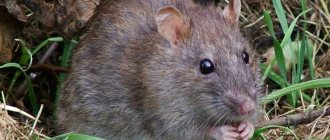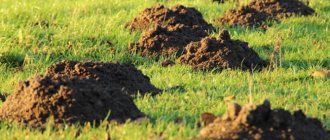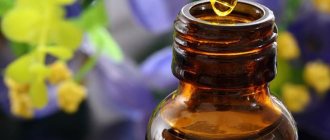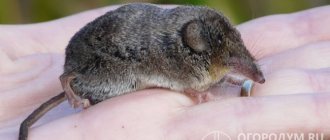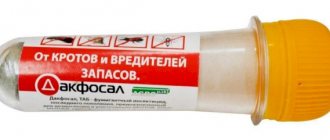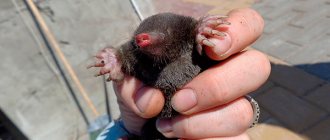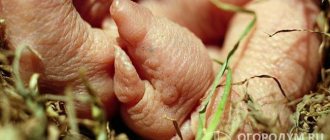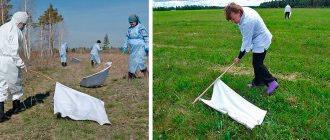Rats do a lot of harm to humans. They destroy and spoil food supplies; they gnaw walls, floors, roofs; cause electrical wiring to become unusable, which may cause a fire. However, this is not even the biggest danger of rats.
Rats are carriers of more than 20 serious diseases, including those that can lead to human death. For this reason, extermination of rodents must begin immediately after their appearance.
Various methods are used to control rats:
- mechanical;
- biological;
- chemical;
- repellent;
- folk remedies.
Description of the species
The water rat is not a classic rat. The water vole is known to the general public under this name. In appearance, the rodent rather resembles a small muskrat or a growing nutria.
The body of the animal reaches 20 cm in length. The weight of the body fluctuates around 300 g. The entire body is covered with fluffy fur. The color can combine different shades of brown, gray and black. The modest ears are practically invisible from under the hair. But the tail is impressively long.
For a long time in Russia, water rat fur was used to make clothing and accessories. The animal was officially a commercial animal.
The tail appendix makes up a bold 2/3 of the carcass size. Round in cross-section, it looks dense, thick and strong. Short hairs are scattered throughout the area. It was for this part of the body that the vole began to be confused with a rat and was nicknamed accordingly.
Lifestyle
The species is distributed throughout the country, except for deserts, arctic zones and high mountain ranges.
The water rat chooses coastal areas to live. In spring and summer, it can most often be found near ponds, swamps, lakes, rivers, and large streams. The animal can also be found in nearby meadows and fields.
This rodent prefers colonial life. The size of the "flock" can be completely different. At a minimum, this is a mother and cubs. There can be from 2 to 4 litters per season. Each includes 5-12 individuals.
The water vole is amazingly active. It is an excellent swimmer, able to dive deep, and copes equally well with climbing logs or leaning trees. Activities are equally successful during the day and at night at any time of the year.
Nests of one colony can be located at distances of several meters from each other. They are connected to each other by branched labyrinths underground. If the soil seems too wet to the rat or the time of flood has come, it will move into a hollow tree or make a house out of reeds on dry land.
The “huts” of such a vole can be distinguished from others by their spherical shape. During periods of decreased humidity, migration will occur in the opposite direction, closer to the water.
The main food is the green and underground parts of plants. Mainly vegetative roots, stems, flowers, bark, buds and succulent leaves are selected.
Prevention is better than cure
In almost all areas of life, prevention is extremely important. It is better to avoid a problem in advance and minimize the likelihood of its occurrence than to struggle for a long time and look for solutions. The situation is similar to the presence of rodents in our homes. There are a number of circumstances whose appearance in the household effectively repels mice and rats.
Here are some of them:
- cats and mice do not like each other, they avoid their company for centuries, because for these small animals it can end tragically. Even now, when owners pamper cats and they do not have enough food, their very presence and smell are effective in repelling rodents;
- order - both mice and rats must have food from which they can establish themselves in the environment. These rodents feed on leftover food, even spoiled food, so leaving unfinished meals or unprotected waste is a real draw. So if we want to avoid annoying little tenants, let's keep our kitchen tidy, keep food in the refrigerator, and don't leave dirty dishes or leftovers in the sink. We also properly secure municipal waste and maintain order throughout the apartment. Pure house mice just don't like it;
- “airtight” interior – these little rodents enter homes through tiny cracks that we may not even notice every day. Therefore, to protect yourself from the horror of a mouse, it is best to thoroughly check the entire house, not just the first floor, because climbing the wall is not a problem for rodents. Critical points are usually where the planks meet the floor, around the roof, installation connections (eg central heating) or other pipes that pass through the wall of the house. If we find even a small defect, it must be tightly closed (for example, using ordinary plaster);
- herbs - odors that mice and rats really don’t like are emitted by some herbs, such as: mint, lavender, tansy, mullet, wild chamomile. Placing this type of grass in your home can deter rodents and keep them away.
Why does he appear at the dacha?
In addition to periodic floods, other conditions can drive a water rat from its permanent habitat:
- excessively increased number of colonies;
- settlement of competitors;
- depletion of food supply;
- the onset of cold autumn.
Relocation from relatives occurs, as a rule, once every 6-7 years. The number of individuals in one territory becomes so large that it is already difficult to obtain enough food and disperse. The same thing happens if rats, mice, ferrets and other rodents suddenly move into the habitat. In such conditions, the water vole looks for new permanent homes to live.
During periods of cold weather, migration is temporary with rare exceptions. The animal digs holes away from cold water, buries old supplies there and replenishes them with local food. Summer cottages are ideally suited for these purposes.
Expert opinion
Mityuk Stefania Bogdanovna
Vegetable gardens within a radius of 5 km from water bodies are in a special risk zone. This is how far an animal is willing to go in search of food.
Reasons for the appearance of earthen and water rats on the site
One of the signs of the appearance of rodents is the appearance of characteristic holes in the ground.
Most often, earth rats prefer to settle in less deserted places: they prefer fields, meadows and swamps. At times they can be found in home gardens and orchards, even in barns and country houses.
Important! Ground rats, despite their size, are not real rats: they are large vole mice.
Causes of water rats:
- Proximity of food: leftover food, uncollected edible garbage, harvested crops. In summer, mice usually find food in the garden, in winter they feed on collected supplies or sneak into storage rooms and houses;
- A large number of shelters: basements, sheds and other non-residential premises, underground passages of moles;
- No threat from humans: earth rats are quite smart and cunning, they have learned to hide successfully.
Damage caused
In vegetable gardens, the water rat creates real terror. In just one winter, a family can turn a cultivated area into a source of chaos. Consequences of this proximity include:
. Each individual eats more than 10 kg of food per season. Not only plants in the garden are used, but also stocks of root crops and grain from the cellars;
large crop losses- garden damage . Flower bulbs, apple bark, and trunks of berry bushes are destroyed. Trees begin to get sick easily from wounds;
- destruction of turf . Along with the roots, the top layer of soil, which is very important for plant protection, is damaged;
- damage to the aesthetic appearance . Holes and piles of discarded earth appear on the territory. Visually, the presence of a rat can be confused with moles;
- increased weed growth . Volatile spores of thistle, gillweed and other “bad” grasses instantly settle on damaged turf. It becomes very difficult to get them out. Without proper treatment, the damaged area will remain so the next year;
- disappearance of beneficial insects and amphibians . In especially hungry times, the rodent does not hesitate to eat small bugs, midges, and frogs.
In addition, the water rat can cause serious harm directly to people. Dangerous infectious diseases (hemorrhagic fever, tularemia, leptospirosis) are transmitted to humans through damaged food and bites. Therefore, it is extremely important to weed out damaged root crops and promptly identify the pest that has taken up residence.
Threats and dangers posed by rodents
Rodents breeding in a cellar, barn, garage, country house or garden plot are a real problem .
Rats can ruin any item from food to expensive equipment. In addition, they carry diseases that are dangerous to humans and animals .
Moreover, you can become infected not only from contact with things on which rodent secretions remain, but also through direct contact with them.
Rats are quite aggressive and can bite a person who gets in their way.
Rats can even cause damage to buildings with their rather powerful teeth.
They can damage electrical wiring , which can result in a fire, chew through floors, and destroy products made of plastic, paper, and wool.
The main danger is their traces on things, from which a person can become infected with tularemia, salmonellosis, toxoplasmosis , etc.
Rats are carriers of more than a hundred viruses and infections. These infections can cause serious harm to health, including death. There are also many known cases of rabies infection from a rat bite.
Signs of presence
It’s not at all difficult to guess that it was a water rat that visited the site. If they can be confused with moles based on the piles of discarded earth, then the remaining signs are very individual:
- trampled beds with stumps of gnawed plants . People call them “feed tables”;
- holes of different sizes and at different distances . Moles have approximately the same characteristics;
- eaten root vegetables. Water rats not only drag beets, potatoes, and carrots into holes, but also gnaw on the spot everything that they cannot carry away;
- nests at the roots of garden trees . They become especially noticeable in winter, when the labyrinths emerge from under the snow;
- there are many individuals of the species in the area . If there are pests in the fields, in other areas, near water bodies nearby, they are unlikely to miss a specific area.
Of course, the most striking indicator would be to spot a water rat in person at the crime scene. Many of them have the audacity to openly dominate foreign territories.
Folk recipes
Earth rats do not tolerate proximity to chamomile.
Folk recipes for exterminating rats are considered less effective, but safer for family members, pets and crops. The most effective include the following:
- Growing plants. The roots of black elderberry release cyanide into the soil, poisoning rats, coniferous plants with needles injure them, burdock sticks to the skin and interferes. It is also worth planting plants that have an unpleasant odor for pests: garlic, mint, hazel grouse, tansy, wormwood, chamomile, juniper;
- Smoking. You will need to burn mint, wormwood or old rubber before entering the holes. The latter can be left for several days after burning. A sharp, unpleasant stench will force mice to run away.
- Use of gasoline and kerosene. It is necessary to wet pieces of rags and place them in front of the holes; you can also pour a glass of fuel inside. They note that the method gives almost instant results, but it must be used carefully, since gasoline spoils the soil and groundwater.
How to fight
The best fight is prevention. It will be much more difficult to remove rats than to reduce the attractiveness of the site for their settlement.
The main safety measure is to maintain the dacha in a well-maintained condition. If there is a lot of garbage in the garden, thickets of bushes, unharvested crops, carpets of rotten grass, favorable conditions are created for the pest. In such an environment, it is very easy for a rodent to hide its home and get easy food
Regular cleaning of the garden, digging up the soil, and clearing the shoreline of nearby bodies of water greatly reduce the likelihood of a vole appearing. It helps a lot to lay a fine mesh netting in the planting holes.
When the flock has already started, you need to act decisively. We will have to resort to extermination measures, possibly a whole complex.
Traditional methods
Experienced gardeners say that you can deal with water rats without much expense. The working “old-fashioned” methods include:
Burnt wool
The smell of burnt hair is unbearable for rodents. In a humane version, a set fire to a piece of any skin or fur from an old fur coat/boot/hat is thrown into the hole. Inhumane - they burn the dead carcass of a rat or mouse.
Ash
Ash is a caustic alkali. It easily sticks to the paws, is eaten with food and causes acute poisoning in the animal. If you scatter ash over an area, you can get a beneficial side effect in the form of fertilizing the soil.
Black elderberry
It is beneficial to plant a couple of such trees on the site. Elderberry roots saturate the soil with odorous cyanide. The rats won't stay with her scent.
Cats and dogs
Natural enemies of rodents chase and strangle their prey. Few litters will want to remain under the gun of a hunter.
Conifer needles
Spruce or juniper branches are generously sprinkled on the ground and tree roots for the winter. They act in the same way if raids on surrounding territories begin. The needles injure the sensitive paws of rodents, which repels them.
Expert opinion
Mityuk Stefania Bogdanovna
All these measures can have both long-lasting and weak effects.
Repellent
If traditional methods are ineffective or undesirable, they switch to sound scaring and traps:
- Classic mousetraps, rat traps, nooses, buckets, boxes with bait (old root vegetables) are installed at the entrances to burrows, hidden in bushes, under grass near tree roots and in reeds near ponds. The industry produces suffocating traps on springs, with electric discharges (Victor), and adhesive ones.
- Audio exposure is provided using special ultrasonic devices. This option is preferable in areas with few trees so as not to block the waves. The Tornado 400 device is most effective.
You cannot use toxic substances and traps in dachas where pets and children roam. They may unwittingly become victims.
Such measures are suitable for moderate numbers of uninvited guests. Dangerous conditions and the first victims will force the colony to migrate further away.
Chemical bullying
Are there water rats on your property?
It happened, it didn't happen
The most radical way to exterminate water rats. Other animals, insects, and, if used carelessly, people themselves may suffer from the drugs. Therefore, it is recommended to resort to extreme measures only in case of strong stubbornness of rodents or their high numbers.
The poison is poured into holes, water, and placed with food as bait. After eating, the chemical begins to decompose the nervous system, blood, affects the digestive tract, and paralyzes breathing. The result is a painful death of the animal. The corpses must be collected a few days after the “attack” and burned.
Expert opinion
Mityuk Stefania Bogdanovna
Modern drugs mummify the victim, so the carcass will not decompose, smell, and it is easy to miss the moment of destruction. It is necessary to monitor the area after treatment so that the cat or dog does not eat the carrion. Poisoning can be fatal.
Proper use of chemicals involves repeated baiting after the first time. The second approach excludes the appearance of adaptation of the rat body to small doses of poison.
Experienced summer residents found the following drugs to be the most effective:
| Name | Description | Price |
| Storm | Briquettes or pellets. Pronounced effect within a week after treatment. Mummifies corpses. The taste is not attractive to pets. | About 50 rubles |
| Nutcracker | The paste is red or blue. Placed in or near burrows in drink caps or other containers to remove human odor. The effect occurs within 4-8 days. | About 100 rubles |
| Rat death number one | Very toxic paste. Place in containers strictly wearing gloves and a mask. It is better to place the poison inside the holes. Livestock death in 2-3 days. | About 60 rubles |
| Efa | Briquettes or pellets. Causes internal bleeding and death from it. Works in 3-5 days. Does not release poison into the air. They are laid out under thick grass, in places difficult to reach for humans, birds and animals. | About 50 rubles |
| Zernotsin | Granules for wet soil. Made from compressed wheat, which is attractive to rodents. They pour into holes. Death of livestock on 7-8 days. Requires repeated use. | About 20 rubles |
Each site owner determines the advisability of using a particular method in his own personal opinion. If there is an excessively large influx of water rats or there is no desire to fight it on your own, you can always call a professional service for treatment.
Chemicals for rat control
Chemical preparations for rodent control - rodenticides - are available in different forms. These can be granules, powders, ointments, briquettes, aerosols, etc. To deceive wary rats, instead of poisonous bait, regular food is placed in their places of movement for several days. After this, a poisonous drug is added to it. This makes it much more likely that the rat will eat the bait.
Chemical agents used to kill rodents act in different ways.
Some of them have a fast-acting effect and cause poisoning of animals and their rapid death. These are rodenticides whose active ingredient is zinc phosphide or ratsid. A single dose is enough to cause the death of a rodent. However, the effect often depends on how much poison he ingested, so a rat may survive with a small dose. Moreover, smart rodents very quickly begin to recognize the poisonous bait and stop eating it.
Other drugs have a cumulative (accumulating) effect and are classified as blood anticoagulants. When using most anticoagulants, a single use is not enough - the rat must eat such poison for at least several days. The active ingredients in these drugs may be warfarin, coumatetral, triphenacin, etc. (first generation anticoagulants), as well as brodifacoum, difenacoum, bromadiolone, etc. (second generation anticoagulants). After they enter the body, blood clotting gradually decreases and the walls of blood vessels are damaged, which ultimately leads to the death of the rodent. Most rat control chemicals currently fall into this group.
Interesting to know!
If optimal conditions are created for the life of a mammal, the field mouse will multiply very quickly. Up to 400 pests can be counted on one hectare.
The pest rests calmly in its shelter during the daytime, and goes out hunting during the day. This is the second reason preventing the fight against the earth rat. The rodent can rarely be found within the city. The stronger representatives of the genus - gray rats - do not allow them into their abode. Yes, they don’t need to. Why leave so many attractive places to live? After all, the main source of food for rodents is in the garden plot - these are the roots of plants and flowers, and loose soil that does not impede their movement. in the ground, they make holes and passages, cutting off the entire root system of plants encountered on their way. This is the third reason why it is difficult to control pests.

